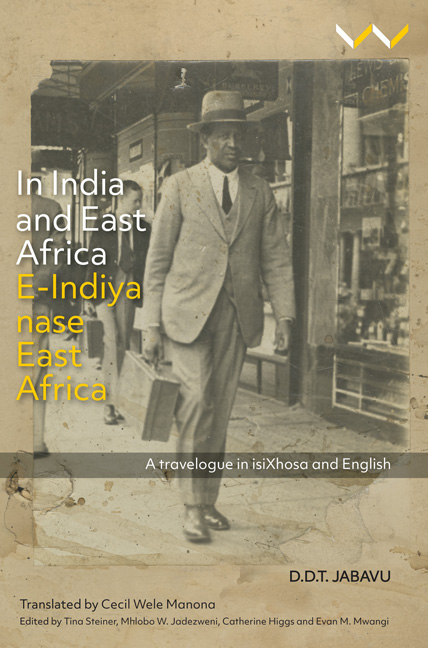Book contents
- Frontmatter
- Contents
- List of Illustrations
- Maps
- Acknowledgements
- Networks of Solidarity: D.D.T. Jabavu’s Voyage to India
- Revisiting D.D.T. Jabavu, 1885–1959
- Notes on the Original and the Translation
- In Praise of Cecil Wele Manona, 1937–2013
- E-Indiya nase East Africa
- In India and East Africa
- Afterword: Jabavu and African Translations for the Future
- References
- Editors’ Biographies
- Index
Chapter 5
Published online by Cambridge University Press: 27 March 2020
- Frontmatter
- Contents
- List of Illustrations
- Maps
- Acknowledgements
- Networks of Solidarity: D.D.T. Jabavu’s Voyage to India
- Revisiting D.D.T. Jabavu, 1885–1959
- Notes on the Original and the Translation
- In Praise of Cecil Wele Manona, 1937–2013
- E-Indiya nase East Africa
- In India and East Africa
- Afterword: Jabavu and African Translations for the Future
- References
- Editors’ Biographies
- Index
Summary
Nairobi
It happened that my presence in Mombasa was known in Nairobi, which is in the centre of Kenya, and in Kampala (Uganda) to people who were my students at Fort Hare in 1932. They had heard about my presence from Indians who were with me on the ship. Immediately I received telegrams and phone calls offering me train fares so that I could visit them. And I began to realise that the idiom ‘nothing succeeds like success’ holds true. On Friday 20 January 1950 in the afternoon I left for Nairobi, a distance of 330 miles, 5 453 feet above sea level. The road was steep through extensive forests like the ones between De Aar and Beaufort West. In the morning, we saw wild animals which were kept in a reserve near the railway line: elephants, springbok, giraffes, and many others. I was much impressed by the kudu, I think it would be a sin to kill it. I was pleased to see them in their natural environment.
After breakfast we arrived in Nairobi, where I was met by my host, Elind Mathu, B.A., LL.B., M.L.C., who is an honourable member of parliament to whom I had taught Latin and who was very bright. In Mombasa, I was told by an Indian member that in parliament there is no brighter person than Mathu, whether he be an Indian or a white person. I spent 6 days with him, travelling 80 to 90 miles a day in his own car. Upon my arrival, he asked his assistants to show me the city, shops which were owned by blacks and the locations. We went to his home (a distance of 16 miles) which was worth £5 000. In the afternoon, we toured the coffee plantations, black-owned shops, villages of the Kikuyu (his countrymen), the Swahili, Maasai, Kamba and Chaga. He also took me to the homes of men who had studied at Fort Hare recently, people like Njonjo, Kabetu, Njoroge, Kiong Githu and Waruhiu. I noted that all the shops are built of stone, he has three of his own. From there he took me to a large market of the Maasai, people who originate from the north, these are tall people whose colour is dark brown.
- Type
- Chapter
- Information
- In India and East Africa / E-Indiya Nase East AfricaA Travelogue in isiXhosa and English, pp. 256 - 264Publisher: Wits University PressPrint publication year: 2019



